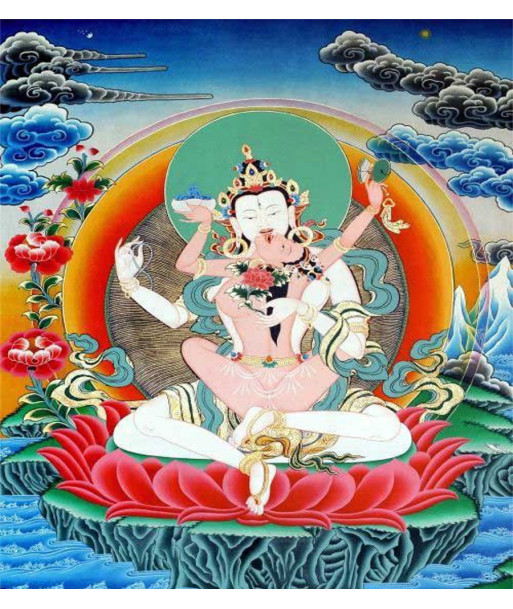- -50%





A **Sambhogakaya Yab Yum Thanka** painting depicts the Yab Yum (Father-Mother) form of deities in Tibetan Buddhism, specifically focusing on the Sambhogakaya aspect of the Buddha's manifestation. In this form, the deities are shown in a union that represents the inseparable nature of wisdom and compassion.
 Security policy
Security policy
(edit with the Customer Reassurance module)
 Delivery policy
Delivery policy
(edit with the Customer Reassurance module)
 Return policy
Return policy
(edit with the Customer Reassurance module)
A **Sambhogakaya Yab Yum Thanka** painting depicts the Yab Yum (Father-Mother) form of deities in Tibetan Buddhism, specifically focusing on the Sambhogakaya aspect of the Buddha's manifestation. In this form, the deities are shown in a union that represents the inseparable nature of wisdom and compassion.
### Key Elements of Sambhogakaya Yab Yum Thanka Painting:
1. **Central Figures**:
- **Yab Yum Pair**: The central figures are usually a male and female deity in a consort relationship, embodying the union of wisdom and compassion. These figures are typically:
- **Male Deity (Yab)**: Often depicted as a powerful, wrathful or peaceful deity, such as a form of **Vajradhara**, **Avalokiteshvara**, or **Heruka**, representing the masculine principle of wisdom and skillful means.
- **Female Deity (Yum)**: The female deity, or consort, is often depicted as **Vajrayogini**, **Kurukulle**, or another wisdom goddess, representing the feminine principle of compassion and beauty.
2. **Iconography**:
- **Yab (Father)**: The male deity is usually depicted in a dynamic posture, often seated or standing, with a fierce or peaceful expression. He may hold ritual implements such as a vajra, bell, or sword.
- **Yum (Mother)**: The female deity is often shown embracing or seated upon the male deity, symbolizing their inseparable union. She may be adorned with elaborate jewelry and holds attributes like a lotus or a kapala (skull cup).
3. **Union Symbolism**:
- **Embrace**: The Yab Yum pair is depicted in a close embrace, symbolizing the unity of wisdom and compassion. This union represents the essential interconnectedness of these qualities in achieving enlightenment.
- **Three Eyes**: Both deities may have three eyes, signifying their ability to perceive all aspects of reality and the profound vision of enlightened wisdom.
4. **Background and Surroundings**:
- **Mandala**: The background often includes a mandala or a sacred landscape, representing the enlightened realm or pure land where the deities reside. This setting reinforces the sacred and transformative nature of their union.
- **Symbolic Details**: Additional elements may include flames, lotus flowers, or other auspicious symbols that enhance the divine nature of the deities and the spiritual context of the painting.
5. **Color and Style**:
- **Vibrant Colors**: The thanka may feature vibrant colors to highlight the divine and transformative nature of the deities. Gold, red, and blue are common colors used to represent different aspects of their power and qualities.
- **Detailed Artistry**: The painting typically exhibits intricate details and elaborate patterns, reflecting the complexity and depth of the deities' symbolic significance.
6. **Mantras and Texts**:
- **Inscriptions**: Tibetan script or mantras related to the Yab Yum deities’ practices and qualities may be included around or within the painting. These texts are used in rituals and meditations to invoke their blessings and to deepen understanding of their union.
### Significance:
- **Wisdom and Compassion**: The Sambhogakaya Yab Yum Thanka symbolizes the profound union of wisdom and compassion, illustrating how these qualities work together in the path to enlightenment. The union of the male and female deities represents the inseparability of these essential aspects of the enlightened mind.
- **Meditation and Ritual**: The thanka is used in meditation and ritual practices to connect with the deities' qualities and to cultivate both wisdom and compassion. Practitioners focus on this union to integrate these qualities into their own spiritual practice.
- **Symbol of Enlightenment**: The depiction of the Yab Yum pair in union is a powerful symbol of the ultimate state of enlightenment, where wisdom and compassion are perfectly harmonized.
The Sambhogakaya Yab Yum Thanka painting is a profound spiritual tool that reflects the deep and transformative teachings of Tibetan Buddhism, illustrating the essential union of wisdom and compassion in the path to enlightenment.